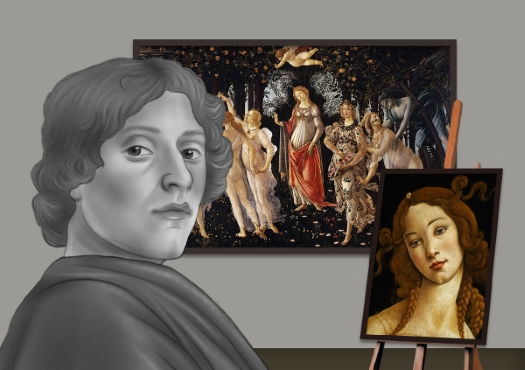Botticelli was perhaps the greatest humanist painter of the Early Renaissance, yet much of his life and influences remain a mystery to us today. His paintings represent the pinnacle of the cultural flourishing of the Medicis’ Florence, a prosperous society that encouraged the progress of art, philosophy and literature. Throughout his long career he was commissioned to paint many different subjects, but at the heart of his work he always strove towards beauty and virtue, the qualities represented by the goddess Venus, who is the subject of many of his most famous paintings.
This painting is one of the best-loved works of art in the world. Although Botticelli lost favor after his death, his reputation was revived in the late 19th century and since then The Birth of Venus has risen to international fame. The painting depicts the goddess of love, Venus, sailing to shore from the sea on a giant shell. She is blown into land by Zephyr, the god of the west wind, while a female attendant waits with a cloak.
Like the slightly earlier Primavera, The Birth of Venus is groundbreaking for presenting a non-religious scene from classical mythology on such a large scale. Moreover, the inclusion of such a prominent female nude at near-life-size was virtually unprecedented in Western painting. The work plays an obvious homage to classical art, emulating the “Venus Pudica” style of a nude female figure attempting, but not quite succeeding, to preserve her modesty with her hands and in this case her erotically charged long hair.
Botticelli’s reference to classical sculpture in Venus’ pose is overt, as she stands in the contrapposto stance with her weight on one foot, which was favored by Greco-Roman art and emulated by early Italian Renaissance artists. Intriguingly, the stance is so exaggerated that it is anatomically impossible, and the figure stands improbably on the edge of the floating shell. In this way, Botticelli also refers back to the Gothic tradition that preceded the Renaissance, where emphasis was placed on symbolism and status rather than on realistic depiction. It is interesting, therefore, that Botticelli’s most famous work has come to stand for Italian Renaissance art in the popular imagination, even though it eschews many of the key tenets of the later movement in favor of aesthetic beauty and an overall idea.
Tempera on canvas – The Uffizi Gallery, Florence
Source: https://www.theartstory.org



 Sandro Botticelli, The Birth of Venus, 1483-85,
Sandro Botticelli, The Birth of Venus, 1483-85, 
